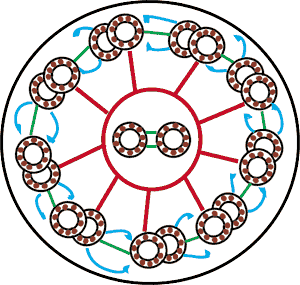|

Cross Section of a Cilium
|
Cilia are composed of bundles of microtubules arranged in a 9+2 pattern. In
the center of the cilium are two unpaired microtubules. Nine paired bundles lie around the periphery of the cilium.
The bundles of microtubules are held together by three types of cross-linking proteins. These cross-links occur
periodically along the length of the cilium much like the rungs on a ladder. The central unpaired bundles are connected
by a protein called nexin and the outer paired bundles are also connected by
nexin bridges. Spoke-like proteins radiate from the sheath-like ring that surrounds the two inner bundles.
These spokes connect to the larger ring of the paired outer microtubule bundles.
Motion depends on the cross links between the paired outer microtubules that are formed by the protein dynein. These proteins are capable of "walking" along
the microtubules, causing the microtubules to slide past eachother. If this happens only in microtubules on one
side of the cilium, the cilium bends. The alternate bending of the cilium in different directions is responsible
for ciliary motion.
next |
